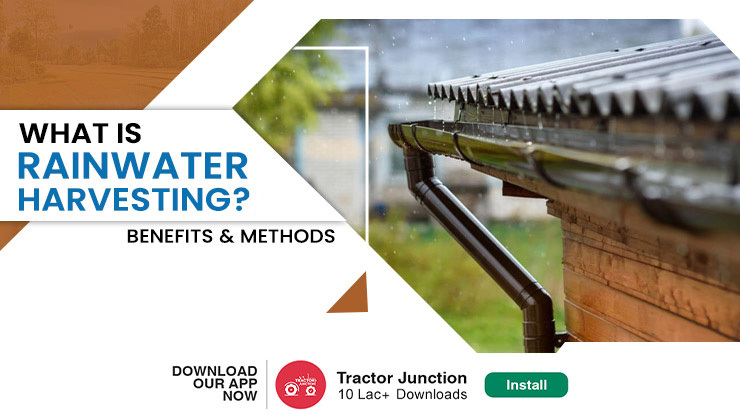
Introduction to Rainwater Harvesting!
Do you know almost 80% of India’s total water resources are required for agricultural purposes?
Almost 48.6% of India’s total 140 million hectares of farmland is irrigated. The increasing water use to irrigate the field has reduced water flow downstream. The constant flow of river water to the plains has led to water scarcity.
Popular fields of Punjab, Haryana, Uttarakhand and western Uttar Pradesh draw abundant water from the Himalayan river, leading to water scarcity. In the wake of depleting water resources, rainwater harvesting systems are the best alternative to store and use run-off water whenever possible.
Wondering what is rainwater harvesting? Or, more specifically, the importance of rainwater harvesting in meeting farming fields’ requirements.
Read on, as we are about to discuss how collecting rainwater helps and what exclusive techniques you can adopt to irrigate your land for a better harvest.
What is Rainwater Harvesting in India?
Rainwater harvesting is a traditional practice of collecting, storing & preventing run-off rainwater for irrigating arid or semi-arid agricultural fields. This practice is suitable for watering crops or providing water to farming facilities. This way, farmers can save their water bills big times.
Following, we are going to show you the procedure of rainwater harvesting. Have a look down below.
-
Surface Runoff Harvesting
Surface runoff harvesting contains 2 different methods of rainwater harvesting.
a.) Contour Trenches – In this method, you have to dig trenches with the contour to collect and slow down the water runoff so that water can absorb in the soil.
b.) Contour Bunds – It is a process to build low dams with the contour to prevent soil erosion and trap rain water.
-
Rooftop Rainwater Harvesting
Rooftop Rainwater Harvesting comes with 2 different methods of rainwater harvesting.
a.) Gutters and Downspouts – You have to utilise gutters and downspouts to gather rainwater from the roof and channel it into storage tanks or cisterns.
b.) First Flush Diverters – You have to ensure that cleaner water is collected by diverting the initial runoff, which might contain contaminants away from the storage system.
-
Surface Water Harvesting
Surface water harvesting contains 2 different methods of rainwater harvesting.
a.) Percolation Pits – You have to create pits to allow rainwater to seep into the ground, improving groundwater recharge.
b.) Ponds and Check Dams – In this method, check dams or ponds are built to collect and hold rainwater in naturally occurring watercourses or depressions.
-
Groundwater Recharge
The Groundwater Recharge water harvesting system also has 2 methods including recharge wells and recharge shafts.
a.) Recharge Wells – Drilling wells are intended to let rainwater soak into the aquifer and replenish groundwater reserves.
b.) Recharge Shafts – It was building vertical shafts that let rainwater seep straight into the aquifer underneath.
-
Subsurface Dams
The Subsurface Dams water harvesting system also has 2 methods including Sand Dams and Check Dams.
a.) Sand Dams – Restoring groundwater can be accomplished by building low, permeable dams in riverbeds to collect and hold water beneath the sand.
b.) Check Dams – These are built over small streams or rivers, much like sand dams, to slow down the encouraged groundwater recharge and flow of water.
-
Fog Nets
The Subsurface Dams water harvesting system has 1 method including Fog Harvesting.
a.) Fog Harvesting – You have to catch water droplets from fog using specially made nets, especially in dry or coastal areas.
-
Urban Rainwater Harvesting
a.) Stormwater Management Systems – We have to create and put into place systems in cities to collect and control precipitation runoff from the pavement, roads, and other surfaces.
-
Rain Barrels and Tanks
a.) Storage Tanks – It is installing underground or above-ground tanks to hold rainwater that has been collected for later use.
b.) Ferrocement Tanks – You have to build durable tanks with a cement and metal mesh combination.
-
Water-Saving Landscaping
a. ) Ferrocement Tanks – Planting native plants in landscaping spaces to absorb rainwater and lessen runoff.
b.) Permeable Paving – Constructing driveways and walkways out of porous materials to let rainwater seep into the earth.
Importance of Rainwater Harvesting
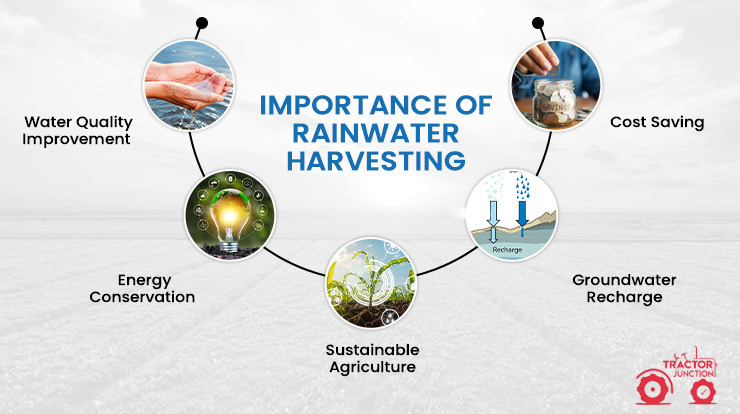
For environmental sustainability, rainwater harvesting is important for various factors, including social benefits and other economic and ecological reasons. In the following, we are going to show you the importance of rainwater harvesting.
- Water Quality Improvement – Rainwater is free from numerous impurities that are present in other water sources. Rainwater collection before it hits the ground can improve the quality of the water and lessen the need for intensive water treatment procedures.
- Energy Conservation – Energy-intensive processes including extraction, treatment, and distribution are needed for conventional water supply systems. Local rainwater harvesting lowers the energy required for centralized water supply, promoting energy efficiency and a lower carbon impact.
- Sustainable Agriculture – Rainwater gathering encourages sustainable farming practices and lessens the stress on nearby water sources by supplementing irrigation needs, particularly in rural regions.
- Groundwater Recharge – Rainwater harvesting helps restore groundwater aquifers by guiding rainfall into the ground. This is crucial to keeping wells, boreholes, and other groundwater-dependent systems supplied with a steady and dependable supply of water.
- Cost Saving – Communities and individuals can save money by installing rainwater collection systems. It provides an alternate, affordable source of water, so there’s less need for costly water infrastructure improvements and water costs are reduced.
Benefits of Rainwater Harvesting
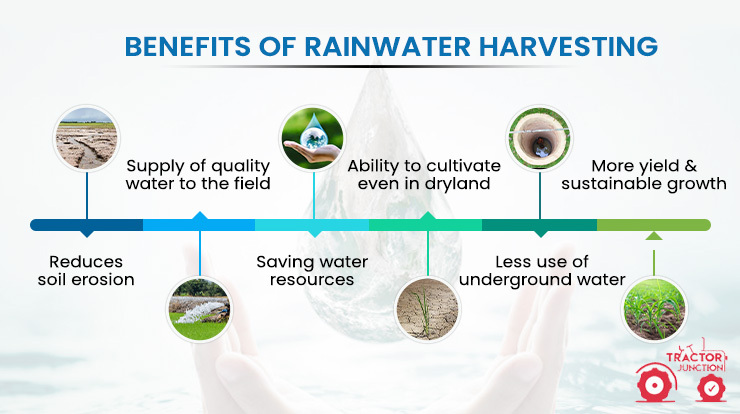
Rainwater harvesting helps farmers in a lot many unimaginative ways as follows:
1. Reduces soil erosion
With rainwater harvesting, the water gets collected in specified containers, which lessens water pressure on the field. This eventually helps reduce soil erosion, stormwater runoff, flooding, and contamination from pesticides, metals, chemical fertilisers & other detrimental sediments.
Also Read: How to reduce the effects of soil erosion?
2. Supply of quality water to the field
Rainwater is free from additives, minerals and dissolved salts, which is why it is a great source of watering for the field.
3. Saving water resources
Collected rainwater is helpful in irrigating agricultural fields and facilities. This way, farmers can save on their water bills and freely use water without heavily relying on rain or reservoir.
4. Ability to cultivate even in dryland
Do you know 65% of all 43 million hectares of arable land is dry and reliant on rainfall? Moreover, 40-50% of food grain production in India is fulfilled from dry land. With With collected water, it gets easy to cultivate even in dry lands or semi-arid regions.
Also Read – How to increase water absorption in dryland?
5. Less use of underground water
Creating sources for underground water is expensive and time-consuming. Many parts of the world realise the importance of rainwater and minimising groundwater use to irrigate the field.
Making use of rainwater sources whenever required or possible is a must. Moreover, during the case of drought or when groundwater supply appears scarce, collected or stored rainwater comes to the rescue.
6. More yield & sustainable growth
Collected water can be filtered and cleaned to ensure better growth & yield of the plants.
You can remove impurities like salts, debris, or other sediments from plants and soil for better quality during the treatment.
Rainwater collection is often devoid of various pollutants and man-made toxins. Additionally, rain is not chlorinated. The cost of general property upkeep and landscaping requirements can be reduced by using clean, healthy rainwater for plants and trees.
These were the advantages of rainwater harvesting; now, let’s look into some popular methods that are worth adopting.
Types of Rainwater Harvesting
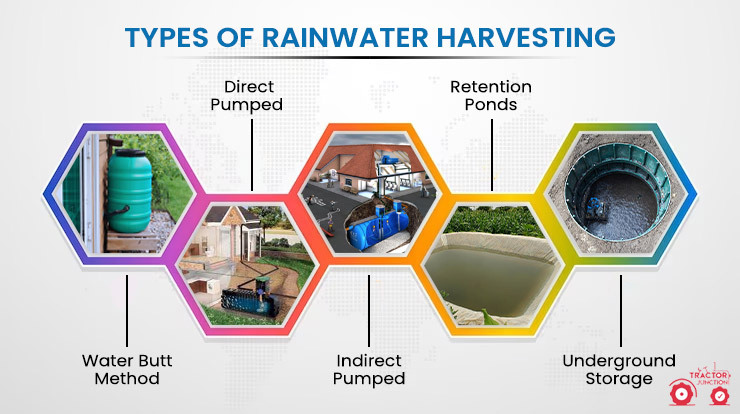
There are 5 types of rainwater harvesting and all vary according to the regions. From these 5 types you have to select the best suited one. The following few types of rainwater harvesting methods are available for farmers in India.
1. Water Butt Method
The water butt is a device that collects water from natural rainfall and collects or stores it in containers. The water collected is helpful for watering the field regularly or during dry seasons.
2. Direct Pumped
Direct pumped is another popular harvesting method that is usually ideal for small fields, backyards or garden areas. This type of rainwater harvesting system is helpful in irrigating small pieces of land or, more particularly, gardens.
3. Indirect Pumped
The method involves using booster pumps to draw water to the tank or structure (available on the floor) with great force or pressure. Water delivery to the outputs in this kind of rainwater harvesting system doesn’t rely on gravity.
The best thing about this system is that booster pumps easily customised. Meaning you can adjust their flow & pressure depending on their needs & preferences.
4. Retention Ponds
Retention ponds are another efficient and effective type of rainwater harvesting system that helps collect runoff water and increase its quality. They usually built of mud bottom and have a concrete liner for robust collection.
Farmers often use retention pods to water cattle. However, they also use it for drinking, irrigating field, replenishing groundwater replenishment, or performing non-potable water tasks.
5. Underground Storage
Underground storage tanks are another kind of rainwater harvesting system that is suitable in areas where rainfall happens for only one season.
These subsurface storage tanks are safe well-insulated, and safe from rapid evaporation. Moreover, since these tanks are built below the frozen line, their water doesn’t freeze anytime soon. This works better than over-the-surface storage tanks (as they are more prone to water freezing).
However, to use the collected & stored water of these tanks, you can connect these underground tanks with electric pumps to draw the water towards the required outlets.
What is The Need of Rainwater Harvesting
Rainwater harvesting is crucial for many regions which are facing environmental challenges and water scarcity. It recharges groundwater, mitigating droughts, reducing flooding and erosion, promoting sustainable agriculture and conserving energy. Along with this, it encourages community empowerment, reducing dependence on external water sources and adaptation of climate change.
Challenges with Methods of Rainwater Harvesting
Although rainwater harvesting is quite safe and friendly on water bills. Little did people know that this system has a few gaps or challenges that are still unmet. Following are some methods mentioned.
Following are some disadvantages of rainwater harvesting.
1. Unpredictable/uncertain Rainfall
In India, not all regions or states experience the same quantity of rainfall or precipitation. In some places, the quantity can be huge, whereas, in some areas, the quantity of rainfall can be slim to none. It’s a tall order to predict or forecast rainfall.
So, choosing rainwater collection systems in areas where rainfall is less is not a vital choice. It should be done in areas where rainfall is abundant.
2. Home to chemical-Based sediments
The stored or collected water can become home to certain types of chemicals, insects, animal waste or dirt, which might not be suitable for irrigating the field or supplying cattle.
This will call for additional costs of attaching a filter to make the water potable or at least safe from impurities.
3. Infestations from rodents
The water tanks can become infested with rodents, mosquitoes, insects or even algae growth, which will further contaminate the water. If they not cleaned or managed within time, they could become breeding grounds for different species.
4. The process is technically savvy & costly
The cost of installing a harvesting system is a one-time cost as you get great returns in the form of 50% saving on water bills on an ongoing basis. However, it’s the installation process that can be challenging for many. It would require expert supervision to install the entire structure.
Government Initiatives of Rainwater Harvesting
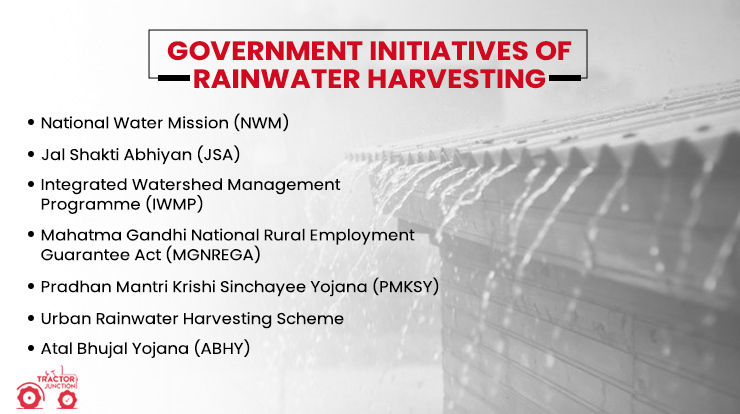
In India, the Government launched many initiatives to promote water conservation and rainwater harvesting. Following, we are showing some key government initiatives to support rainwater harvesting.
- National Water Mission (NWM) – National Water Mission (NWM) is one of the 8 missions of the National Action Plan on Climate Change (NAPCC). It encourages water harvesting and sustainable water management techniques.
- Jal Shakti Abhiyan (JSA) – The Jal Shakti Abhiyan started in 2019 by the government of India that focuses on various water conservation projects including rainwater harvesting. Main aim of the project is to spread awareness about water conservation.
- Integrated Watershed Management Programme (IWMP) – Integrated Watershed Management Programme (IWMP) programme aims to manage watersheds for sustainable development. Government wants to enhance the amount of water available in rainfed areas. It includes operations such as rainwater harvesting, afforestation, water and soil conservation.
- Mahatma Gandhi National Rural Employment Guarantee Act (MGNREGA) – Mahatma Gandhi National Rural Employment Guarantee Act (MGNREGA) includes provisions for water management and conservation, and projects implemented under this program that ensure employment in rural areas often include rainwater harvesting.
- Pradhan Mantri Krishi Sinchayee Yojana (PMKSY) – Enhancing agricultural water use efficiency is the goal of the PMKSY. To meet farmers’ needs for irrigation, it has provisions for collecting rainwater and storing water. Enhancing agricultural water use efficiency is the goal of the PMKSY. To meet farmers’ needs for irrigation, it has provisions for collecting rainwater and storing water.
- Urban Rainwater Harvesting Scheme – In India, numerous urban local bodies and state governments have started initiatives and policies to promote rainwater harvesting in urban areas. These programmes frequently offer financial rewards or legal restrictions to encourage the installation of rainwater harvesting systems in buildings.
- Atal Bhujal Yojana (ABHY) – A programme called ABHY was introduced to encourage sustainable groundwater management and enhance the state of groundwater resources. One common recommendation for recharging aquifers is to harvest rainwater.
There are some other state specific initiatives by the government of India to encourage water conservation in India. Some states provide financial assistance, technical support or rainwater harvesting awareness programs.
Conclusion of Rainwater Harvesting
Rainwater harvesting is an ages-old technique that started with creating guls & kuls (man-made channels used priorly to collect & store water). Nowadays, modern rainwater harvesting methods involving direct/indirect pumped methods, retention ponds, and underground storage are available to help collect and store water.
Along with these techniques, farmers can save up to 50% of their water bills and irrigate their fields without worrying about water scarcity. Hope with the above methods, you will be able to effectively irrigate your field without heavily relying on frequent rainfall or groundwater resources.
Therefore, to make your farming more efficient, make sure to add top-quality farming tractors and implements from ace brands to increase crop productivity. If choosing a single tractor out of endless options is difficult, try this easy-to-use, Tractor comparison tool to narrow down your choices.
Frequently Asked Questions on Rainwater Harvesting
Q1. What is the main purpose of rainwater harvesting?
Ans. Rainwater harvesting is useful in collecting & storing rainwater for either domestic consumption or for irrigating the fields in the case of arid or semi-arid regions. Moreover, it is the best method to increase the groundwater table.
Q2. What are the traditional methods of rainwater harvesting?
Ans. Earlier, people used to build Guls and Kuls, which are traditional methods of rainwater harvesting. Guls & kuls are channels created in hilly and mountainous regions to deviate water for the purpose of drinking and so forth.
Q3. Why is rainwater harvesting important?
Ans. Rainwater harvesting is important to recycle scarce water resources and increase the water table of the ground.
Q4. Why should people implement rainwater harvesting?
Ans. Rainwater Harvesting is easy & fastest way to reduce water consumption. With harvesting rainwater systems, saving up to 50% of a family’s regular water usage in a household is easy. This helps check water bills and the environment.
Q4. How to harvest rainwater at home in India?
Ans. Following are the simple processes of rainwater harvesting at home:
- Cleaning your catchment area
- Redirecting water with pipes
- Installing rain separator and storage tank filter
- Overflow pipe for the extra water
Q6. Which state is famous for rainwater harvesting?
Ans. Tamil Nadu is famous for rainwater harvesting in India.
Q7. In which year rain water harvesting started in India?
Ans. In 2001 rain water harvesting started in India.
Q8. Who started rainwater harvesting in India?
Ans. Tamil Nadu chief minister J Jayalalithaa started rainwater harvesting in India.
Q9. Where is rainwater harvesting used in India?
Ans. Rainwater harvesting used in the Thar Desert population of Rajasthan. And, now it is mandatory in the new housing society Pune.
Related Post
Top 5 Rainy Season Crop to Grow this Monsoon Season
What is Dryland Farming in India

